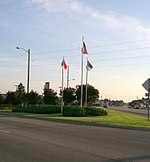Pope Field
1919 establishments in North CarolinaAirfields of the United States Army Air CorpsAirfields of the United States Army Air Forces I Troop Carrier CommandAirfields of the United States Army Air Forces in North CarolinaAirfields of the United States Army Air Service ... and 8 more
Buildings and structures in Cumberland County, North CarolinaFayetteville, North Carolina metropolitan areaInitial United States Air Force installationsInstallations of the United States Air Force in North CarolinaPopulated places in Cumberland County, North CarolinaPopulated places in North CarolinaPortal templates with redlinked portalsUnited States Army airfields

Pope Field (IATA: POB, ICAO: KPOB, FAA LID: POB) is a U.S. military facility located 12 miles (19 km) northwest of the central business district of Fayetteville, in Cumberland County, North Carolina, United States. Formerly known as Pope Air Force Base, the facility is now operated by the U.S. Air Force via a memorandum of agreement (MOA) and an interservices support agreement (ISSA) with the U.S. Army as part of Fort Liberty.
Excerpt from the Wikipedia article Pope Field (License: CC BY-SA 3.0, Authors, Images).Pope Field
Lewis Street,
Geographical coordinates (GPS) Address External links Nearby Places Show on map
Geographical coordinates (GPS)
| Latitude | Longitude |
|---|---|
| N 35.170833333333 ° | E -79.014444444444 ° |
Address
Pope Field
Lewis Street
28308
North Carolina, United States
Open on Google Maps






